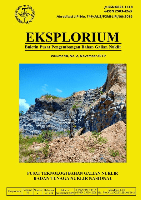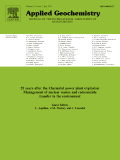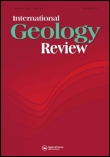
Eksplorium-Buletin Pusat Teknologi Bahan Galian Nuklir
Scope & Guideline
Pioneering Research in Nuclear Material Technology
Introduction
Aims and Scopes
- Geological Exploration and Characterization:
The journal emphasizes the exploration and characterization of geological materials, particularly those relevant to nuclear energy, such as uranium and thorium, along with rare earth elements, which are essential for various technological applications. - Environmental Geochemistry and Remediation:
Research on the environmental impact of mining and industrial activities, including studies on pollution and remediation techniques, such as phytoremediation, is a key focus area, reflecting the journal's commitment to sustainable practices. - Geophysical and Geochemical Methodologies:
The publication showcases innovative methodologies in geophysics and geochemistry, including gravimetry, seismic tomography, and analytical validation techniques, to enhance the understanding of geological structures and mineral resources. - Resource Management and Sustainability:
A consistent focus on the sustainable management of mineral resources, including waste management and land suitability analysis for mining activities, highlights the journal's dedication to responsible resource utilization. - Interdisciplinary Research:
The journal promotes interdisciplinary studies that integrate geology, environmental science, and engineering, fostering collaborations that address complex challenges in resource exploration and management.
Trending and Emerging
- Rare Earth Element Research:
There is a significant increase in studies focusing on the distribution, characteristics, and extraction of rare earth elements, driven by their rising importance in technology and renewable energy sectors, reflecting a global trend towards resource diversification. - Environmental Impact Studies:
Emerging themes related to environmental impacts of mining activities, particularly studies on pollution and remediation strategies, are gaining traction, indicating a heightened awareness of sustainable practices in resource management. - Geophysical Data Utilization:
The use of advanced geophysical methods, such as satellite gravity data and seismic tomography, is on the rise, showcasing a trend towards integrating high-tech solutions in geological research and exploration. - Interdisciplinary Approaches to Resource Management:
There is a growing trend towards interdisciplinary research that combines geology, environmental science, and engineering, aiming to address complex challenges in resource management and environmental sustainability. - Geochemical Exploration Techniques:
Innovative geochemical exploration methods are increasingly prevalent, particularly in identifying mineralization prospects and assessing geological formations, which aligns with the current demand for efficient resource identification.
Declining or Waning
- Traditional Geology without Technological Integration:
Research that solely focuses on traditional geological studies without the integration of modern technological methods, such as advanced geophysical techniques or environmental assessments, has become less prominent, as the field moves towards more technologically sophisticated approaches. - General Mineralogy Studies:
Broad mineralogy studies that do not connect to specific applications or advanced techniques are declining. The journal appears to be favoring more focused research that directly addresses practical applications, particularly in nuclear technology and environmental sustainability. - Static Geological Mapping:
The emphasis on static geological mapping, which lacks dynamic assessments or the application of modern data analytics, is waning, as there is a growing preference for studies that utilize real-time or high-resolution data to inform geological assessments.
Similar Journals

Bulletin of the Mineral Research and Exploration
Illuminating the Path of Mineral Research and ExplorationBulletin of the Mineral Research and Exploration, published by MADEN TETKIK VE ARAMA GENEL MUDURLUGU-MTA in Turkey, is a prominent open-access journal that has been disseminating vital research in the fields of geology and geotechnical engineering since 1936. With an ISSN of 0026-4563 and a commitment to sharing knowledge without barriers, this journal fosters an inclusive environment for researchers, professionals, and students alike. The journal is recognized for its contribution to the scientific community, illustrated by its Q3 ranking in Geology and Q4 ranking in Geotechnical Engineering and Engineering Geology for the year 2023. Despite its solid performance, the journal remains dedicated to improving its Scopus rankings, currently positioned at #230 out of 321 in Earth and Planetary Sciences for Geology, and #169 out of 229 in Geotechnical Engineering. The journal's historical convergence of years emphasizes its longstanding relevance and adaptability in disseminating cutting-edge research. By offering open access, it ensures that vital geological and engineering insights are readily available to a global audience, thereby enhancing collaboration and advancing knowledge in these crucial fields.

LITHOLOGY AND MINERAL RESOURCES
Illuminating the Path from Lithology to Resource StewardshipLITHOLOGY AND MINERAL RESOURCES, published by PLEIADES PUBLISHING INC, is a specialized journal dedicated to advancing knowledge in the fields of economic geology, geochemistry, and petrology. With its ISSN 0024-4902 and E-ISSN 1608-3229, this journal has established itself as a critical resource for scholars and practitioners alike, examining the intricate relationships between lithology and mineral deposits, and their implications for resource management. As indicated by its positioning in the Q3 quartile for both economic geology and geochemistry and petrology in 2023, the journal is recognized for its valuable contributions to the scientific community, ranking #28 out of 43 in Economic Geology and #112 out of 154 in Geochemistry and Petrology according to Scopus. The journal's publication history reveals a rich tradition of excellence, as it has been continuously contributing to the field from 1984 to 2024. While it does not offer open access options, researchers and practitioners can easily engage with its robust body of work in effective ways to support their own studies and applications. The importance of LITHOLOGY AND MINERAL RESOURCES lies in its commitment to publishing high-quality research that informs practices in mineral exploration and environmental stewardship, making it an essential resource for anyone invested in the future of earth sciences.

Geoenergy Science and Engineering
Connecting Science and Engineering for a Greener TomorrowGeoenergy Science and Engineering, published by Elsevier in the Netherlands, is a burgeoning academic journal dedicated to the interdisciplinary exploration of geoenergy technologies. With ISSN 2949-8929 and E-ISSN 2949-8910, the journal serves as a crucial platform for disseminating research and advancements in the fields of energy engineering, geotechnical engineering, and sustainable energy practices. Spanning years from 2023 to 2024, it aims to publish high-quality original research, reviews, and case studies that address the pressing challenges and innovations within the realm of geoenergy. Although the journal currently holds modest Scopus rankings, it is poised to increase its impact and recognition in its respective fields, making it an essential resource for researchers, professionals, and students engaged in the urgent quest for sustainable energy solutions.

BOLETIN GEOLOGICO Y MINERO
Advancing Geological Knowledge Through Rigorous ResearchBOLETIN GEOLOGICO Y MINERO is a significant academic journal published by the Instituto Geológico Minero de España, focusing on the fields of Geology and Geochemistry. Established in 1980, this journal provides a platform for researchers to disseminate vital studies and findings in the earth sciences, encompassing an array of topics from mineralogy to environmental geology. Despite its Q4 ranking in both Geochemistry and Petrology and Geology categories as of 2023, the journal serves as a resource for emerging research and innovative methodologies in these critical fields, promoting a deeper understanding of geological processes and materials. While currently operating without an open-access model, the journal is committed to advancing knowledge through rigorous peer-review standards. With its roots in Spain, the BOLETIN GEOLOGICO Y MINERO significantly contributes to the European geological research community and remains an invaluable resource for students, professionals, and researchers alike engaged in the pursuit of geological science.

Natural Resources Research
Pioneering research for a sustainable future.Natural Resources Research is a premier academic journal that plays a vital role in advancing the field of environmental science, particularly in the management and sustainable use of natural resources. Published by Springer, the journal boasts an impressive impact factor and is currently ranked in the Q1 quartile for Environmental Science, reflecting its significant contribution to knowledge and research in this domain. With a notable ranking of #21/233 in the general environmental science category and a remarkable 91st percentile, it serves as a reputable platform for researchers, professionals, and students seeking to publish and access high-quality research. The journal's archival span from 1996 to 2024 underscores its longstanding commitment to addressing pressing environmental issues, facilitating robust discussions on natural resource policy, conservation strategies, and innovative technological advancements. While the journal is not open access, it ensures wide dissemination of its content, bolstering the critical dialogue necessary for enhanced understanding and action in the field. Natural Resources Research continues to be an essential resource for those dedicated to sustainability and the responsible stewardship of our planet's resources.

Acta Geochimica
Innovating Geochemistry and Petrology for Tomorrow's Discoveries.Acta Geochimica is a prominent academic journal published by SPRINGER INT PUBL AG, focusing on the dynamic fields of Geochemistry and Petrology. Established in 2016, this peer-reviewed publication has quickly gained recognition within the scientific community, currently holding a category quartile ranking of Q3 in Geochemistry and Petrology as of 2023. With its ISSN 2096-0956 and E-ISSN 2365-7499, the journal offers a platform for researchers and professionals to disseminate and discuss significant advancements in the study of the chemical composition of the Earth and other celestial bodies. While it is not an open-access journal, Acta Geochimica plays a vital role in fostering collaboration and innovation among scientists, contributing to a deeper understanding of geochemical processes. Located in Switzerland at Gewerbestrasse 11, Cham CH-6330, Switzerland, this journal is a critical resource for students, researchers, and professionals seeking to push the boundaries of knowledge in Earth sciences.

Visnyk of Taras Shevchenko National University of Kyiv-Geology
Innovating Geological Research for a Sustainable FutureVisnyk of Taras Shevchenko National University of Kyiv-Geology is a premier academic journal dedicated to advancing the field of geology and related earth sciences. Published by the esteemed NATL TARAS SHEVCHENKO UNIV KYIV, this journal serves as a vital platform for researchers, professionals, and students to disseminate original research findings, innovative methodologies, and comprehensive reviews that address contemporary geological challenges. With an ISSN of 1728-2713 and an E-ISSN of 2079-9063, the journal is committed to upholding rigorous academic standards and excellence, although it currently operates without an open access model. The Visnyk primarily focuses on topics such as mineralogy, geophysics, geological engineering, and environmental geology, thus providing a broad spectrum of insights into the ever-evolving discipline of geology. Situated in Kyiv, Ukraine, it not only fosters local research but also contributes to the global geological discourse, making it an indispensable resource for anyone engaged in earth sciences.

APPLIED GEOCHEMISTRY
Unraveling the Complexities of Earth’s Chemical InteractionsApplied Geochemistry is an esteemed peer-reviewed journal published by Pergamon-Elsevier Science Ltd, dedicated to advancing the field of geochemistry by exploring the intricate relationships between geological processes and environmental chemistry. With a significant impact factor and prestigious standing in various categories, including Environmental Chemistry, Geochemistry and Petrology, and Pollution, Applied Geochemistry is classified within the Q2 quartile, reflecting its influence and recognition in the scientific community. The journal spans research contributions from 1986 to the present, focusing on critical issues such as the impact of geochemical processes on the environment, the evaluation of pollution sources, and innovative methodologies in geochemical analysis. Through its rigorous publication standards, Applied Geochemistry serves as a vital resource for researchers, professionals, and students seeking to enrich their understanding of geochemical phenomena and their implications for environmental health. Please note that access to the journal is not open; therefore, institutional or individual subscriptions may be required for full-text viewing.

DOKLADY EARTH SCIENCES
Advancing Knowledge in Earth and Planetary SciencesDOKLADY EARTH SCIENCES is a reputable journal published by MAIK NAUKA/INTERPERIODICA/SPRINGER, focusing on the dynamic field of Earth and Planetary Sciences. With an ISSN of 1028-334X and E-ISSN 1531-8354, this journal offers a platform for researchers to disseminate their findings and insights that contribute to our understanding of Earth systems over a continuous publishing span from 1998 to 2024. It currently holds a Q3 quartile ranking in the Earth and Planetary Sciences category, reflecting an emerging yet significant impact within its field, evidenced by its Scopus ranks where it stands at 123rd in general Earth sciences and 113th in miscellaneous Earth sciences. DOKLADY EARTH SCIENCES aims to bridge research gaps and foster collaboration among a diverse audience including researchers, professionals, and students committed to advancing knowledge in geoscience. The journal stands as a vital resource for those seeking to explore contemporary challenges and innovations within the realm of Earth sciences.

INTERNATIONAL GEOLOGY REVIEW
Elevating the discourse in Earth and planetary sciences.INTERNATIONAL GEOLOGY REVIEW, published by Taylor & Francis Inc, is a premier journal dedicated to advancing the field of geology since its inception in 1959. With its Q1 ranking in the field of Geology for 2023, this journal is a significant platform for researchers, professionals, and students exploring the intricacies of Earth and planetary sciences. The journal has been rated in the 81st percentile within Scopus rankings, reflecting its influence and the high quality of articles published. Although it does not offer Open Access options, the journal maintains a rigorous peer-review process to ensure the publication of original and impactful research. With an extensive archive projected to continue until 2024, INTERNATIONAL GEOLOGY REVIEW serves as an essential resource for those seeking to deepen their understanding of geological phenomena, making it a vital contributor to the global scientific community.